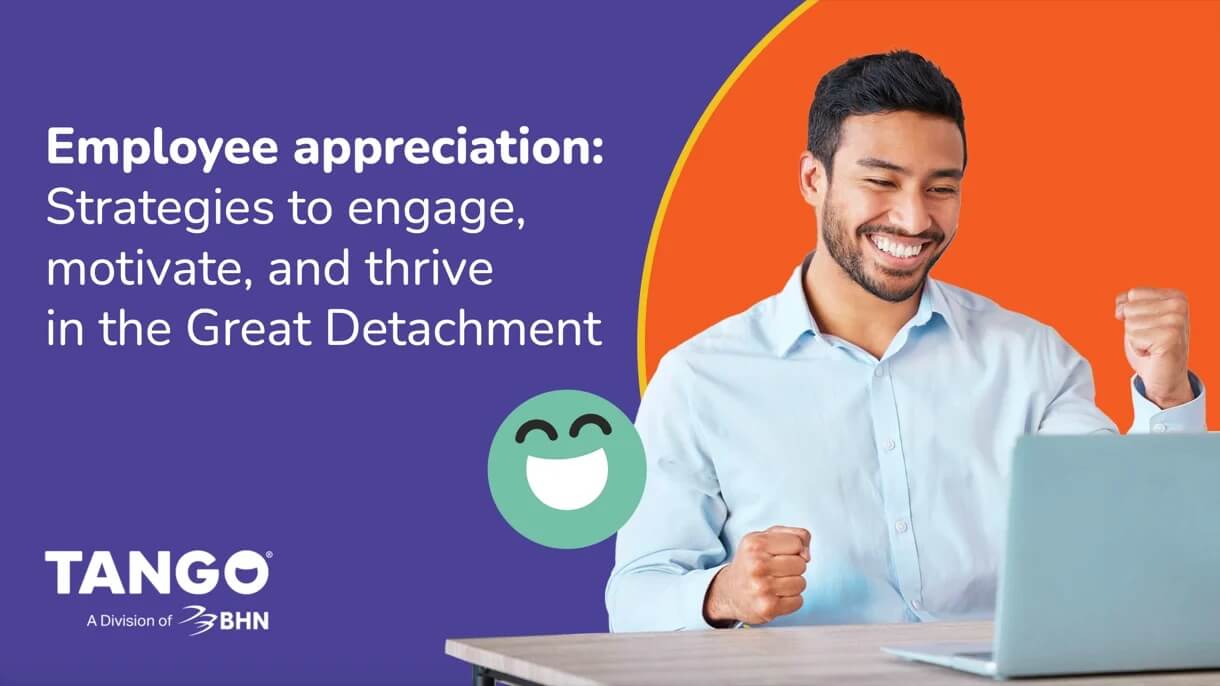Now available: Bulk physical cards with personalization!
Get a demo to see physical options
Now available: Bulk physical cards with personalization!
Get a demo to see physical options



Employee reward programs are essential for recognizing and valuing staff contributions. In addition to boosting employee morale and motivation, these programs can also drive tangible business results.
According to Gallup, organizations with higher employee engagement ratings report higher levels of profitability and productivity. Ongoing recognition, feedback, and development conversations have been proven to drive better employee engagement and retention.
Employee rewards and acknowledgement are additionally important given that nearly 20% of employees surveyed by McKinsey in 2025 reported dissatisfaction with their employer, but only 7% had clear plans to leave. This gap highlights the risk of "quiet quitting," where employees disengage without formally resigning.
Enter employee reward programs, which can help foster a positive workplace culture and encourage high performance. This guide will explore strategies for designing and implementing successful programs.
Employee reward programs are structured systems designed to recognize and reinforce employee contributions. These programs can take many forms—from formal incentive plans to spontaneous acts of appreciation—but their shared purpose is to consistently acknowledge the value employees bring to the organization.
Reward programs can be tailored to suit different company cultures, team dynamics, and business goals. Whether implemented through digital platforms or in-person initiatives, the most effective programs are those that feel authentic, equitable, and aligned with what employees care about.
Core elements of successful reward programs include:
Technology plays a key role in scaling and managing these efforts. Platforms like Tango help HR teams automate reward delivery, track engagement, and ensure fairness across the organization.
Employee rewards are the tangible and intangible incentives organizations use to recognize effort, celebrate achievements, and reinforce desired behaviors. These rewards can be structured or spontaneous, individual or team-based, and monetary or non-monetary.
Common types of employee rewards include:
The strength of a reward program lies in its flexibility. Personalized rewards—those that reflect an employee’s values, interests, or goals—are far more impactful than one-size-fits-all solutions. For example, some employees may value public recognition, while others prefer private appreciation or opportunities for growth.
Employee reward programs can play a significant role in creating a positive work culture. Recognition is fundamental in showing employees that their hard work is valued. Still, many employees don’t feel sufficiently recognized. According to recent data by Tango and Blackhawk Network, although 77% of employees say receiving rewards and recognition from their employer makes them feel valued, only 38% say their company has a relevant program.
Losing employees is costly: Professionals in technical roles typically cost about 80% of their annual salary to replace, while replacing frontline employees costs around 40% of their salary. Not to mention that 42% of employees who voluntarily leave a role believe their departure could have been prevented according to the same data set.
Affirming employee contributions with rewards can go a long way—indeed, 73% of employees say that rewards and recognition from an employer keep them energized all year. A well-designed employee rewards program can lead to increased satisfaction, loyalty, and ultimately, engagement.
Employee engagement is a pivotal metric. Employees who strongly agree that they receive adequate recognition for their work are four times more likely to be engaged in their job—and engagement drives key outcomes.
Data from 3.3 million+ employees shows that highly engaged teams experience:
When leaders make employee engagement and recognition a priority, they can significantly boost morale, setting the stage for stronger performance and lasting success.
Thoughtful employee appreciation adds a personal touch to the relationship between employers and employees. Appreciation doesn't always require a large budget—small creative gestures can have a significant impact.
Consider these employee appreciation ideas:
Not sure what your employees will enjoy? Consider sending small-denomination Reward Links—employees can choose between 100+ gift cards, prepaid cards, and donation opportunities.
Surprise and delight employees with creative tokens of appreciation. Unique, well-timed employee rewards are memorable and meaningful.
Some creative employee appreciation ideas include:
Gamification, in particular, is gaining traction as a fun and effective way to engage employees. A recent Harvard Business Review article highlights how incorporating game-like elements into reward programs—such as letting top performers spin a “wheel of wow” for prizes—can make recognition more interactive and enjoyable.
Employee appreciation doesn’t have to be complicated to be effective. A great example comes from Overcoming U a wellness education company that needed to increase participation in its online well-being courses.
By partnering with Tango and offering digital gift card incentives, Overcoming U transformed its engagement strategy. The results were dramatic: course completion rates jumped from an industry average of just 10% to as high as 80%.
The key? Simplicity and choice. Digital rewards were easy to distribute and gave employees the freedom to select something meaningful to them. This approach not only boosted participation but also reinforced a culture of appreciation and personal growth.
Employee engagement initiatives are essential for fostering a committed and productive workforce.
Key components of effective engagement initiatives include:
Generational preferences also play a role in shaping engagement strategies. According to Gallup, Millennials and Gen Z employees are 73% more likely than Baby Boomers to want recognition at least a few times a month. Younger workers also prefer recognition that is personalized, public, and tied to meaningful work, while older generations tend to value private, formal acknowledgments.
Bridging this gap requires a flexible approach that offers multiple recognition formats and frequencies to meet diverse expectations.

Employee rewards are a powerful lever for engagement. The right rewards can validate effort, reinforce positive behaviors, and help employees feel that their contributions are important. However, personalization is key.
While 78% of employees say they understand what motivates them, only 33% feel their organization recognizes those motivators, according to Deloitte. This gap presents a major opportunity for organizations to tailor rewards more effectively.
Influential reward strategies include:
When rewards are timely, relevant, and aligned with individual motivators, they deepen engagement and inspire sustained performance.
Aligning employee rewards with organizational goals ensures that recognition drives the right behaviors and outcomes. When employees understand how their efforts contribute to broader success, they’re more likely to stay focused and motivated.
Strategies to strengthen this alignment include:
McKinsey’s 2024 global survey found that employees are most motivated when performance management systems are simple, consistent, and clearly linked to company strategy. By connecting rewards to strategic goals, organizations can foster alignment, accountability, and a stronger sense of purpose.
When employees feel appreciated, they’re more likely to be engaged, loyal, and enthusiastic about their work.
To effectively boost morale, reward programs should include:
Experiential rewards are especially impactful. Experiences like travel, classes, or events create lasting memories and emotional connections—often more powerful than cash.
Despite increased awareness about the significance of engagement in the workplace, many employees still feel overlooked.
According to a 2025 Harvard Business Review article, only 39% of employees strongly agree that someone at work cares about them. Many employees report feeling invisible or emotionally disconnected. Leaders who consistently acknowledge contributions—through small gestures, check-ins, or public praise—can reverse this trend and foster a culture of care.
Key psychological benefits of recognition include:
When leaders model intentional recognition, it cascades through teams—amplifying trust, motivation, and emotional resilience across the organization.
To ensure reward programs are effective, it’s essential to measure their impact on employee morale. Tracking the right metrics helps organizations refine their approach and demonstrate ROI.
Ways to measure impact include:
By combining qualitative and quantitative data, companies can identify what’s working, where gaps exist, and how to evolve their programs to better support morale and engagement.
Launching a successful recognition program requires thoughtful planning and alignment with company values. A well-structured rollout ensures the program is inclusive, meaningful, and sustainable.
Key steps for implementation:
A successful launch sets the tone for long-term impact. When employees understand the “why” and “how” behind recognition, they’re more likely to engage with and champion the program.
Recognition programs shouldn’t be static. To remain effective, they must evolve with employee needs, company growth, and cultural shifts.
Best practices for sustaining recognition include:
Sustained recognition builds a culture where appreciation is embedded in daily interactions, not just annual reviews.
Even the most well-intentioned reward programs can face obstacles. To be effective, these initiatives must be thoughtfully designed, consistently executed, and aligned with company culture. When programs fall short, they can lead to confusion, disengagement, or even backlash.
Key challenges include:
Protecting employee information is critical, and solutions like Tango prioritize data security and compliance to mitigate risks. Proactively addressing these challenges helps ensure reward programs remain credible, inclusive, and impactful.
Even small missteps can undermine the effectiveness of a reward program. Avoiding these common pitfalls can help maintain employee trust and enthusiasm:
A thoughtful, responsive approach ensures that recognition feels authentic and equitable across the organization.
Launching an employee reward program is only the beginning—successful implementation requires strategic planning, cross-functional support, and the right tools.
Strategies to overcome common implementation hurdles include:
With the right foundation, organizations can build programs that are scalable, secure, and genuinely appreciated by employees.
From boosting morale and engagement to aligning recognition with company goals, the impact of thoughtful rewards is clear. But to truly scale and streamline these efforts, organizations need a partner that understands the evolving needs of today’s workforce.
With secure, customizable solutions built for HR teams, Tango makes it easy to deliver meaningful rewards that resonate with your employees. Whether you're launching a new program or optimizing an existing one, Tango helps you engage employees with choice, flexibility, and ease.
Ready to see how it works? Request a demo and start building a culture of employee appreciation that lasts.
